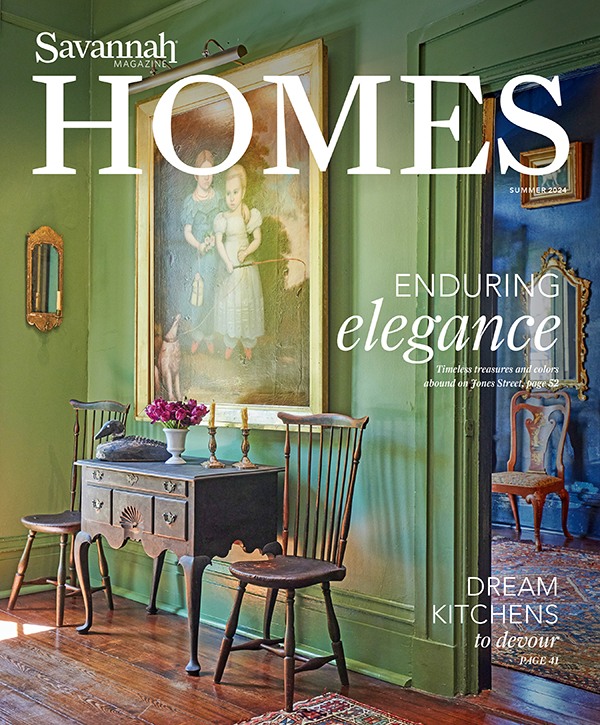A fascination with architecture led one couple to restore an unlikely pair of homes into The Printmaker’s Inn
Written by NICOLE LETTS
Photography by ANDREW FRAZIER
PETER GALLOWAY’S VOICE shifts to an excited pitch as he recounts his interest in bygone buildings. His best childhood memories surround trips from his home in the Chicago suburbs to visit family in the South or to trudge as a tourist through England and Scotland. “[Those trips] were my first intro into really old stuff,” he says.
Later, as a student at Clemson University in the early aughts, Galloway pursued architecture. That is, until a computer-aided design (CAD) professor turned him off from the field, completely shifting his path to graduate with a degree in international business and beginning a career in the corporate world at Johnson & Johnson. After a move across the country to California, Galloway felt that familiar tug back to the South. “I missed old towns; I missed the old buildings. I missed the coast. I wanted to get involved in that [lifestyle],” he says.

When he found the Nichols House at 303 W. Gwinnett St. and its neighboring empty lot, he convinced his wife, Kristen, to move to Savannah to take on the first of several restoration projects. That was 2015. Today, nearly a decade later, Galloway’s property has grown to include not one, but two homes. They comprise The Printmaker’s Inn, a boutique accommodation featuring eight suites with architecture, interiors and furnishings spanning three centuries.



The location couldn’t be beat, but the 5,000-square-foot Nichols House needed some work. Originally built in 1884 for William Nichols, Savannah’s premiere printer at the time, the home later served as a refuge for underserved youth, and beyond that, apartments for Savannah College of Art and Design (SCAD) students. It is even said to have been owned at one point by jazz pianist Nat King Cole.
Despite several iterations over the years, many of the home’s historic details remained intact, including Eastlake ceiling medallions and a reproduction metal fence outside designed by the previous owner’s son, a SCAD graduate. After making mostly cosmetic upgrades, Galloway filled the suites with Victorian-era furniture and antiques, ranging from the Civil War years to the early 1900s.



“We would go to an auction every other week and buy Eastlake mirrors and marble-topped tables,” he recalls. Scouring the internet to find the best auctions and estate sales came to serve Galloway well, especially when it was time to purchase a second, even older property. Only this time, the home wasn’t in Savannah … yet.
“We saw the Hills House for the first time in East Hartford, Connecticut,” Galloway says. Originally built in 1693 for Lt. Jonathan Hills and his wife, Dorothy Hale, the house was expanded in 1742 to its current state by their grandson, Captain David Hills. According to Galloway, the house was essentially preserved in that era for almost 280 years before it was threatened with demolition. The pine flooring, raised panel walls, doors and even the corner cupboard were in their original condition. The real challenge was keeping the house in its pristine state throughout its 917-mile move south.


Every floorboard, timber frame, joist and crown molding was meticulously labeled. Even the chimney, with its original stone and brick likely cured onsite near the Connecticut River, was numbered piece by piece to be reassembled at 303 W. Gwinnett St. “You have your schematics to put it back together, and you just hope it all fits,” Galloway jokes. Like an enormous puzzle, the home was rebuilt to its envisioned glory, right down to its paint. In the parlor bed-chamber, for example, lamp black, a lead white mixed with black pigment, remains the color to this day.
On the exterior, the goal was to achieve the same look that the interior represented. Scouring Palladio pattern books by Batty Langley, an English architect in the early 1700s, Galloway settled on an exterior design. “It is proportioned exactly to Langley’s Palladio proportions and is what he would have done in the 1740s for this style of home,” he says. Woodwork and trim were chosen from Langley’s “The Builder’s Jewel,” as well as his 1740 book, “The City and Country Builder’s and Workman’s Treasury of Designs.” The latter also inspired George Washington’s Venetian window in the New Room at Mount Vernon.

For the decor, Galloway insisted on period furniture and art, focusing his attention on items from the 1690s through the federal period. “Ultimately, it shows the family’s progression as they lived through the house from the 1690s to the early 1800s,” he explains. A desk made by renowned Newport cabinet maker Job Townsend in the 1740s sits in the parlor. In the hall, there is an English portrait by William Beechey, the portrait painter for King George III.
Despite the fine furnishings, the innkeeper wants the Hills Galloway House to feel welcoming for guests as a living, hands-on house museum. He wants people to use the house, sit on the furniture and enjoy the brick bake oven. “We cook oysters; we do wings; we make little pizzas for our kids. We use it all the time, and we’d like for guests to learn how to use it, too,” Galloway says.
What’s more interesting than cooking in a 280-year-old oven? Perhaps spending an entire weekend in its surrounding house.

DETAILS
- Innkeepers: Peter and Kristen Galloway
- Year built: 1693
- Construction/renovation timeline: Research, city approvals, dismantling (2017-2019); reassembly (Jan. 2020-Jan. 2023)
- Neighborhood: Victorian/Historic District
- Bedrooms/bathrooms: 4 bedrooms, 5 bathrooms
- Square footage: 4,000
- Architects: Leonard Baum; Christian Sottile (front portico)
- Builder: Peter Galloway; Anthony Koncul, JAK Homes
- Appliances: Samsung
- Furniture: All antiques, estate sales
- Tile: Mike Adams
- Flooring: Peter Galloway and Anthony Koncul
- Art: antiques
- Paint: Brouns and Co Linseed Paint
- Windows and doors: William Gould windows/window architraves; doors original; front doors recreated by Steve Cook
- Lighting: Antique lighting from auctions and some recreation lighting from Tin Bin
- Landscape: Chatham Nursery
- Noteworthy: All original woodwork, floors, period door hardware and furniture from the 1690s–1830s
All details supplied by the innkeepers



